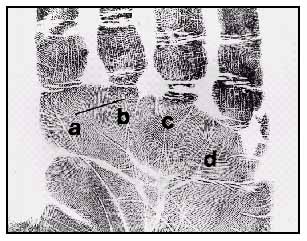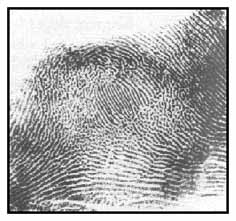- Hand Reading Mini-Course -
PSYCHIATRY - Schizophrenia, dermatoglyphics, a-line, left-right differences & asymmetry
INDEX (P1) - INTRO (P2) - HISTORY (P3-7) - DISEASES - (P8-13) - PSYCHIATRY (P14-25) - PSYCHOLOGY (P26-32) - CONCLUSION (P33-34)
![]()
Hand Diagnostics & Psychiatry:
schizophrenia, dermatoglyphics, a-line, left-right differences & asymmetry
However, in the hands of schizophrenics the horizontal A-line is usually not accompagnied with a high axial triradius - a fundamental difference compared to the hands of people who have Down's syndrome!
Figure C-2: the 'A-B ridge count' is defined as the number of dermal ridges between the 'a-triradius' and the 'b-triradius'.

Ad 3: variations between the right- and left hand
In the past decenium a large number of studies has indicated that schizophrenia is frequently featured with a large number of variations between the right- and left hand. The most frequently observed left-right asymmetry differences in the hands of schizophrenics are:
- The fingerprint pattern1-4
- The 'A-B ridge count'1-4
- The 'total finger ridge count'4-5
- And the position of the axial triradius2.

Figure C-3: an example of
'broken dermal ridges'.
Ad 4: broken dermal ridges
In the medical sciences 'broken dermal ridges' are usually considered as a malformed condition of the dermatoglyphics. An example is presented in figure C-3.
As a result of this malformed condition of the dermatoglyphics, it is hard to follow the path of the dermal ridges and frequently one can no longer distinguish the type of fingerprint pattern. 'Broken dermal ridges' are frequently observed as a feature of specific diseases; schizophrenia is one of these diseases6-7. However, sometimes 'broken dermal ridges' are observed in the hands of perfectly healthy people - this implicates that when this isolated hand feature is observed one should look for other (hand) symptoms to relate this hand feature to a disease.
Sources:
1 - Markow, T.A. & Wandler, K. (1986). Fluctuating dermatoglyphic asymmetry and the genetics of liability to schizophrenia. Psychiatric Research, 19: p.323-328.
2 - Mellor, C.S. (1992). Dermatoglyphic evidence of fluctuating asymmetry in schizophrenia. British Journal of Psychiatry, 160, p.167-172.
3 - Reilly, J.L. et al. (2001). Dermatoglyphic fluctuating asymmetry and atypical handedness in schizophrenia. Schizophrenia research, 50: p.159-168.
4 - Oel, C.J. et al. (2001). Differentiating between low and high susceptibility to schizophrenia in twins: the significance of dermatoglyphic indices in relation to other determinants of brain development. Schizophrenia Research, 52: p.181-193.
5 - Bracha, H.S. et al. (1992). Second-trimester markers of fetal size in schizophrenia: A study monozygotic twins. American Journal of Psychiatry, 149: 10, October.
6 - Bagga A. Leerboek Schizofrenie: een neurologische benadering. 1991.
7 - Bracha, S. et al. (1991). Subtle signs of prenatal maldevelopment of the ectoderm in schizophrenia: a preliminary monozygotic twin study. Biol. Psychiatry, 30: p.719-725.
A brand new masterclass in scientific hand reading is also available here:
Decoding The Language of The Hand:
how to find 36 conditions with just 54 major hand signs!
Common used synonyms for hand reading are: palmistry - palm reading - hand analysis - chirology - chiromancy - chirognomy